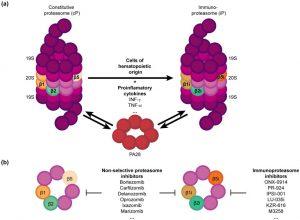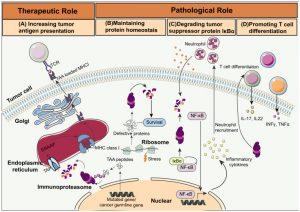The immunoproteasome, a specialized form of proteasome, plays a critical role in enhancing immune responses, particularly in recognizing and presenting tumour antigens. This study explores the immunoproteasome’s potential in cancer therapy, specifically in combination with coffee compounds. Coffee, known for its bioactive components, particularly phenolic, has shown promise in modulating immune responses, making it an interesting companion for immunotherapy.
Additional Reading: ATLAS – describing SARS-CoV-2 variant T-cell responses

Figure 1: Figure 1 Structure and function of proteasomes (A) Constitutive proteasome (cP) vs. Immunoproteasome (iP): The cP includes the subunits β1, β2 and β5, which are respectively substituted with β1i, β2i, and β5i in the iP upon stimulation by pro-inflammatory cytokines such as IFN-γ. The iP is naturally present in hematopoietic cells. IFN-γ also upregulates the regulatory particle PA28, which can bind to both the cP and iP with equal affinity and enhance their activity. (B) Proteasome inhibitors can selectively target iP, or both cP and iP, offering potential immunomodulatory and therapeutic strategies against cancer.
Immunoproteasomes differ from standard proteasomes in their composition and activity, specifically in their ability to generate peptides that are more effectively presented by MHC class I molecules to cytotoxic T cells. This ability enhances immune surveillance, making tumours more recognizable to the immune system. The study also discusses the potential of combining immunoproteasome-targeted therapies with immune checkpoint inhibitors, which have already shown success in treating cancers like melanoma and lung cancer.

Figure 2: Figure 2 Schematic overview of immunoproteasome activities in cancer. (A) Increasing tumor antigen presentation: Immunoproteasomes degrade tumor-associated antigen (TAA) peptides encoded by mutated or cancer germline genes. The transporter associated with antigen processing (TAP) then delivers these peptides into the endoplasmic reticulum (ER). The TAA peptides are trimmed by the ER-associated aminopeptidase (ERAAP), and loaded on MHC I molecules by a complex of tapasin, calreticulin, and ERP57. The MHC I complex loaded with the TAA peptides migrate to the cell surface for presentation to the CTLs. (B) Maintaining protein homeostasis: Immunoproteasomes maintain protein homeostasis and protect cells from proteotoxic stress by degrading non-functional and misfolded proteins. (C) Degrading tumor suppressor protein IkBa: Immunoproteasome-mediated degradation of IkBa leads to NF-kB activation and cytokine secretion, which in turn recruits neutrophils and initiates colitis-associated cancers (CAC). (D) Promoting T cell differentiation: Immunoproteasomes trigger the differentiation of the pro-inflammatory Th1 and Th17 cells, resulting in increased production of IL-17, IL-22, TNF, and IFN-γ.
Coffee’s role in this process lies in its anti-inflammatory and antioxidant properties, which can enhance the immune system’s ability to fight cancer. Specifically, coffee compounds may help reduce oxidative stress in the tumour microenvironment, making cancer cells more vulnerable to immune attacks. This combination of immunoproteasome activity and coffee’s bioactive compounds could improve the efficacy of cancer immunotherapy.
In conclusion, targeting the immunoproteasome alongside coffee’s bioactive compounds presents a novel approach to cancer treatment. Further research is needed to explore the therapeutic synergy between these two elements in clinical settings.
Journal Article: Shi, Shaoyan, et al. “Immunoproteasome Acted as Immunotherapy “Coffee Companion” in Advanced Carcinoma Therapy.” Frontiers in Immunology, vol. 15, 2024.
Summary by Faith Oluwamakinde










